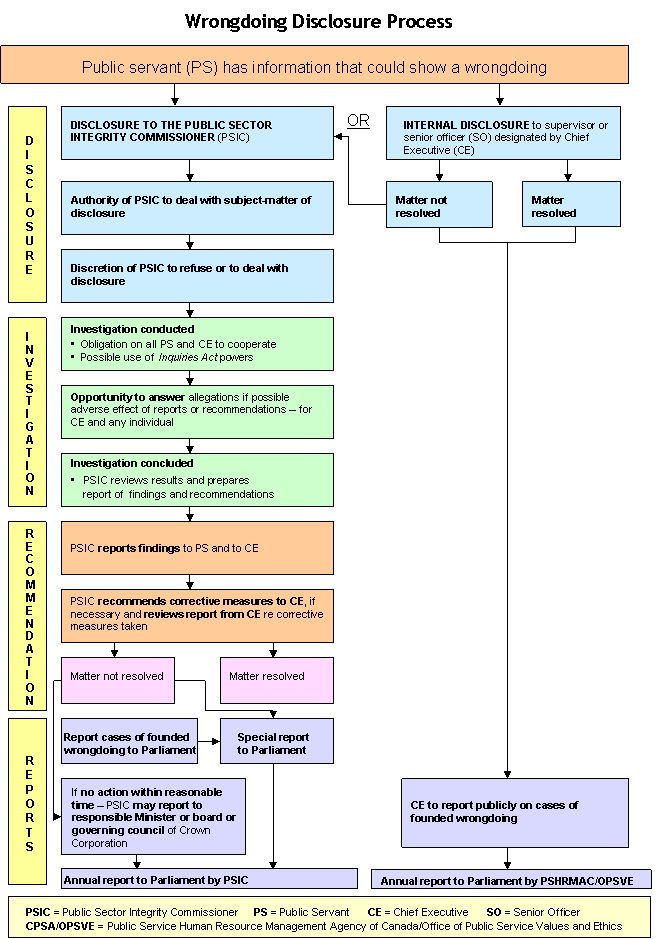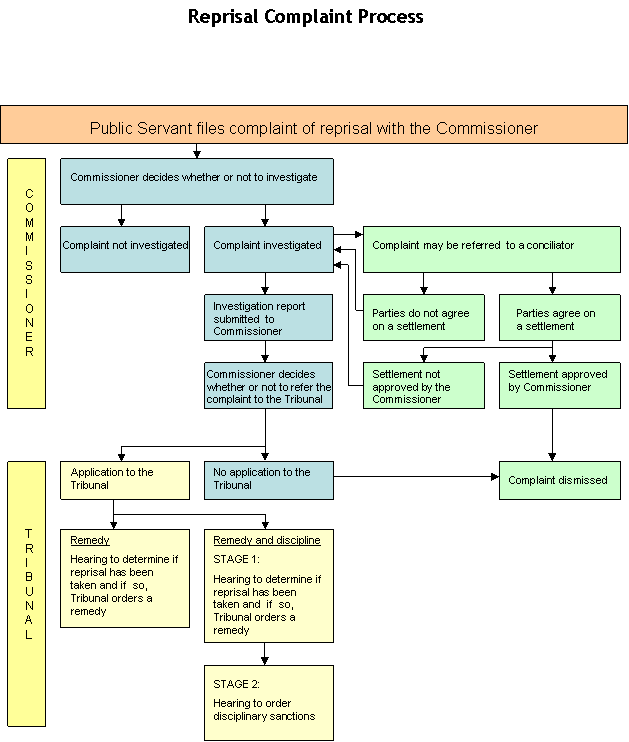Common menu bar links
Breadcrumb Trail
ARCHIVED - Registry of the Public Servants Disclosure Protection Tribunal
 This page has been archived.
This page has been archived.
Archived Content
Information identified as archived on the Web is for reference, research or recordkeeping purposes. It has not been altered or updated after the date of archiving. Web pages that are archived on the Web are not subject to the Government of Canada Web Standards. As per the Communications Policy of the Government of Canada, you can request alternate formats on the "Contact Us" page.
Section III: Supplementary Information
Wrongdoing Disclosure Process
Below are the key steps of the wrongdoing disclosure process.
1. Chief executives must establish an internal disclosure mechanism and designate a senior officer to be responsible for receiving and dealing with disclosures of wrongdoing in their organization.
2. A public servant can make a disclosure of wrongdoing to his/her supervisor, the senior officer designated for this purpose by the chief executive, or the Commissioner.
3. When a public servant makes a disclosure of wrongdoing to the Commissioner, the Commissioner may decide to conduct an investigation.
4. If the Commissioner investigates and determines that the allegation is founded, she recommends corrective measures to the chief executive.
5. The Commissioner submits a report to Parliament outlining her findings and recommendations, and the corrective measures taken by the chief executive.
6. If action is not taken by the chief executive within a reasonable period of time or if there is an imminent risk of danger, the Commissioner may report the matter to the responsible Minister or to the board or governing council of a Crown corporation.
7. A public servant can make a public disclosure only if there is insufficient time to use the mechanisms provided for in the Act. The public servant must have reasonable grounds to believe that a serious offence has been committed under an Act of Parliament or of the legislature of a province, or that there is an imminent risk of danger to the life, health and safety of persons, or to the environment.
A diagram of the wrongdoing disclosure process can be found on the following page.
Source: Public Service Human Resource Management Agency of Canada
Reprisal Complaint Process
Generally, the reprisal complaint process consists of the following key steps.
1. The Commissioner receives a reprisal complaint from a public servant.
2. If the Commissioner decides to deal with the complaint, she designates a person from her office to conduct an investigation. The investigator can recommend to the Commissioner, at any point in the investigation, that a conciliator be appointed to attempt to bring about a settlement.
3. If, after receiving the investigator's report, the Commissioner is of the opinion that it is warranted, she can apply to the Tribunal for a determination of whether or not a reprisal was taken against the complainant.
4. If the Tribunal determines that the complainant was the subject of a reprisal, it can order a wide range of remedies. It can:
- Permit the complainant to return to his or her duties;
- Reinstate the complainant or pay compensation in lieu of reinstatement if the relationship of trust between the parties cannot be restored;
- Pay to the complainant compensation in an amount not greater than the amount that is equivalent to the remuneration that would, but for the reprisal, have been paid to the complainant;
- Rescind any measure or action, including any disciplinary action, and pay compensation in an amount equivalent to any financial or other penalty imposed on the complainant;
- Pay to the complainant an amount equal to any expenses and any other financial losses incurred as a direct result of the reprisal;
- Compensate the complainant, by an amount of not more than $10,000, for any pain and suffering experienced as a result of the reprisal.
5. If requested by the Commissioner, the Tribunal can also order disciplinary action against persons determined to have taken a reprisal, including the termination of employment or the revocation of appointment.
6. Public servants may also choose to deal with reprisals through any other Act of Parliament or collective agreement.
A diagram of the reprisal complaint process can be found on the following page.
Contact Information
Public Servants Disclosure Protection Tribunal Canada
1200 - 270 Albert Street
Ottawa, Ontario K1P 5G8
Telephone: 613-943-8310
Facsimile: 613-943-8325
E-mail: to come
Web site: to be developed
Statutory Responsibilities
The Public Servants Disclosure Protection Act, 2005, c. 46 P-31.9 [Assented to November 25, 2005]


